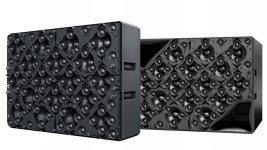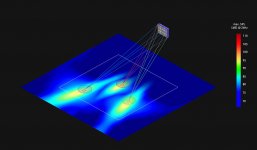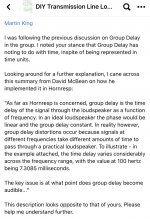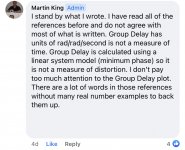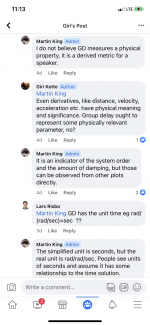Random shower thoughts...
Here's my idea of an array of 19x 1.5" fullrange speakers (Tymphany TC5FC00-04). At low frequency all the drivers work together at about -15dB. At high frequency only the centre driver plays without any attenuation. The outer ring is heavily rolled off at high frequency while the inner ring is rolled off about half as much. By carefully tuning the filters you achieve smooth power response without huge nulls appearing at certain angles like a single large speaker does. Impedance is a near constant ~4ohm. Sensitivity in the 90's @ 2.83V. My plan would be to build as an MTM with a pair of 8" woofers. With a 300Hz crossover you barely get any of the typical MTM problems that you would with a normal 8" MTM/2-way, and the woofers don't have to be anything special since the crossover is so low. Something like a pair of Dayton DA215-8's would probably work well.
I guess there is no reason that you couldn't scale it up to 10 or 12" woofers and a larger array and/or larger fullrange speakers (consider TC7FC00) and bring the crossover below 200Hz if you can cope with a slightly more directional top end. Unless you need stupid SPL then 8" woofers is probably more than enough for home hifi usage.
It makes me thinking of this. I’m not a fan of bose though.
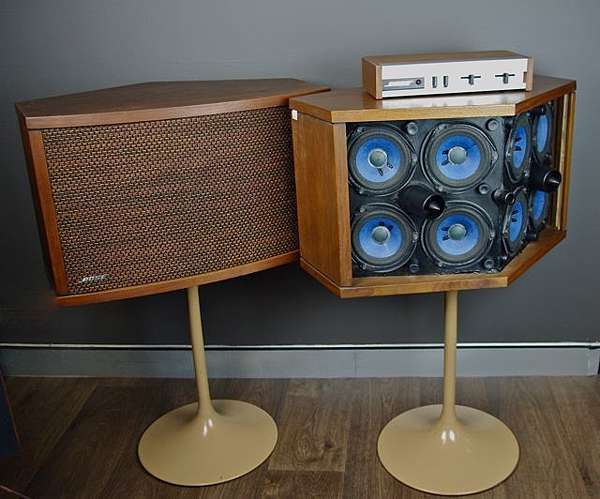
Random shower thoughts...
Here's my idea of an array of 19x 1.5" fullrange speakers (Tymphany TC5FC00-04). At low frequency all the drivers work together at about -15dB. At high frequency only the centre driver plays without any attenuation. The outer ring is heavily rolled off at high frequency while the inner ring is rolled off about half as much. By carefully tuning the filters you achieve smooth power response without huge nulls appearing at certain angles like a single large speaker does. Impedance is a near constant ~4ohm. Sensitivity in the 90's @ 2.83V.
Thanks for sharing your shower revelation.
It somehow reminds me of Bateman's improved array and FollGott's Pseudo-Coaxial, as well as Holoplot's Wavefield Synthesis X1 Matrix Array.
Recently I have been studying similar beam steering systems in response to a request from a friend. He runs a bar that is partly located in 2 medieval vaults, the curved walls of which are also covered with glazed tiles. In short, the worst acoustic conditions imaginable.
Fortunately, research material is available from the groundbreaking collaboration between Rafael Guastavino Jr. and Professor Wallace Sabine.
Attachments
Last edited:
The Holoplot beam forming and steering technology maybe the next big thing in audio.
I remember the first experiments in this field that took place in Germany (where else? ), around the time I became a member of this forum.
), around the time I became a member of this forum.
Participants included the Fraunhofer Institute, Humboldt University, AFMG Technologies, as well as IFAA-Akustik and Four Audio,
the companies of Prof. Dr.-Ing. Anselm Goertz, also the man who tested the Funktion One Evo-Series.
Dr.-Ing. Michael Makarski is a managing partner at IFAA-Akustik.
In short, the technique works like virtually placing a point source at an infinite distance behind the speaker array, leaving you with a near planar wavefront.
I remember the first experiments in this field that took place in Germany (where else?
Participants included the Fraunhofer Institute, Humboldt University, AFMG Technologies, as well as IFAA-Akustik and Four Audio,
the companies of Prof. Dr.-Ing. Anselm Goertz, also the man who tested the Funktion One Evo-Series.
Dr.-Ing. Michael Makarski is a managing partner at IFAA-Akustik.
In short, the technique works like virtually placing a point source at an infinite distance behind the speaker array, leaving you with a near planar wavefront.
Attachments
Last edited:
Someone started a new thread readdressing group delay using David McBeans definition from the hornresp manual, I believe, and King rejected it...lol ...personally I'd like to learn how to convert phase into ms...unwrapped phase, into milliseconds, to be precise...
Still not sure what the finish will be....Ill load some photos of what I have so far...Ive been shy to show here but I think all is on solid ground.
The best idea I've had so far is to buy a six channel focusrite... run crossover with equalizer APO, and from the focus right go into a class amps....any suggestions?
In this idea I figure only one D/A conversion is good. I cane across some material on youtube, suggested to me, suggesting A class as a good choice.
Still not sure what the finish will be....Ill load some photos of what I have so far...Ive been shy to show here but I think all is on solid ground.
The best idea I've had so far is to buy a six channel focusrite... run crossover with equalizer APO, and from the focus right go into a class amps....any suggestions?
In this idea I figure only one D/A conversion is good. I cane across some material on youtube, suggested to me, suggesting A class as a good choice.
Last edited:
Someone started a new thread readdressing group delay using David McBeans definition from the hornresp manual, I believe, and King rejected it
The definition of group delay given in the Hornresp Help file is:
//////////////////////////////////
|Group Delay
~~~~~~~~
Negative derivative in milliseconds of the loudspeaker system phase response, versus frequency in hertz.
Group delay is a measure of the rate of change of phase with respect to frequency, and is positive when the phase slope is negative.
//////////////////////////////////
If the above definition is not correct, then how is it proposed that group delay be calculated?
This is true, my aim was to make the DI increase as gradually and as little as possible and for the off-axis response to be smooth. This way even though the off axis response is tilting down noticably it doesn't have peaks and nulls so it's non-offensive. To make the DI rise more gradually (starting at a lower frequency) requires a much bigger array which is too costly. Also, I didn't want the array to be much bigger than an 8" woofer for aesthetic purposes. Using physically larger full range drivers or spacing out the smaller ones on the baffle to build a physically larger array with minimal increase in cost generally leads to loss of directivity control at high frequency. It'll still be way better than a 'regular' 8" midwoofer and 1" dome tweeter 2-way, which will produce a big hole in power response around 1kHz. These fullrange drivers should also be lower distortion through say 600Hz to 3kHz than all but the most exotic 8" midwoofers.I designed and built a system like this many years ago. It works OK, but as your data shows will have a seriously rising DI curve. Not my goal at any rate.
It's also not very cost effective unless you use inexpensive small drivers, which then seriously limit output power.
TC5FC00 cost $7.26ea which is not expensive but not cheap either when you need 38 of them for a stereo system and you should probably buy some spares to weed out any defective drivers - let's say 45 of them = $326.70. Woofers can be significantly cheaper though so it balances out somewhat, especially if your building a system with 2 woofers per speaker - you're achieving the midrange performance of a 'regular' 2-way system using $200 woofers, but using $40 woofers instead. Ditto versus building a 3-way and spending $50-100 per side on a midrange driver.
Generally with affordable woofers like the Dayton Audio DA and RS series woofers their performance suffers compared to say a $150-200 Scanspeak woofer in the upper midrange (~700Hz up) as the motor don't have nearly as good inductance control. They tend to be uncompromised in the bass, so are perfect for this application.
Last edited:
Group delay is a measure of the rate of change of phase with respect to frequency, and is positive when the phase slope is negative.
I agree with your definition.
Would you agree that by this definition the propagation delay is included in the group delay? If so, then what would you call it when the propagation delay is removed from the group delay?
Would you agree that by this definition the propagation delay is included in the group delay?
Yes.
If so, then what would you call it when the propagation delay is removed from the group delay?
By definition I would still call it group delay, if the rate of change of phase is being measured. I would most likely include a qualifier though, and describe it as adjusted, corrected or normalised, or something similar, depending upon the circumstances.
Many years ago I worked on the conversion of in-service TV transmitters from black and white to colour broadcasting. Checking the group delay characteristics of the transmitters to ensure that they would be up to the task was a key requirement. What I found then and can still see today is that group delay can sometimes be a difficult concept to grasp. The description linked below is a good one for anyone struggling to understand the fundamentals...
Group Delay Basics - More Filter Fun - Circuit Cellar
I didn't mean to leave you guys hanging in conversation… It gets like this for me when I go back to work, it's funny some guys are talking about the year is going to be slow, I have not had less than a 12 hour day since we started back. So here is the post that got me back on to group delay....




Havent heard back from Martin since this transpired, I can't wait to see Mr. King's response, I'm sure it will be juicy
Havent heard back from Martin since this transpired, I can't wait to see Mr. King's response, I'm sure it will be juicy
Attachments
Last edited:
With respect to the discussion earlier about heavy vs. light cones, it's interesting to quote Holger Barske, one of German's prominent (diy)audio gurus, in the review of the Unison Research Max-2 (regarding the 18 Sound 15NLW9300):
"In the MAX-2, a woofer from the Italian specialist Eighteensound is used. Drivers of this manufacturer also fuel the MAX-1.
In fact, the fifteen is a close relative of the twelve inch from the MAX-1 and has the same, but for this application completely over the top specifications: a nominal load capacity of 800 watts is not needed here - the driver is consistently designed with "indestructibility" in mind.
The PA professional likes a maximum stroke of 37 Millimeters, but we need neither the full four-inch voice coil, nor the moving mass of well over
100 grams. Such a driver would not have been my first choice for this project."
I bought a 15NLW9300 to pair with a seos 12 and 15N850 in a quasi "psychoacoustic" 2.5 way. Bi-amped with a GXD8.
It's a very well behaved driver that can cover 40-1400hz with good clarity at respectable spl's.
I find most prosound drivers need a bit of break in before they sound "relaxed". New drivers seem constrained no matter how much power I have available.
Well, Holger's own JBL 2234s do also have a 4" voice coil and mms of > 100 grams. So I don't understand that point of critique. While an xmech of 37 mm isn't interesting for HiFi usage it is also only of particular interest regarding robustness in PA use. No one would reasonably use them like that.
The fact that the manufacturer recommends them for studio monitoring use tells me that they are also usable for home HiFi. There is another driver the 15nlw9500 that has lower fs and higher Qts and can therefore go lower. But it wouldn't have the two-way capabilities of the 15nlw9300.
I think Unison's choice is a reasonable one.
Regards
Charles
The fact that the manufacturer recommends them for studio monitoring use tells me that they are also usable for home HiFi. There is another driver the 15nlw9500 that has lower fs and higher Qts and can therefore go lower. But it wouldn't have the two-way capabilities of the 15nlw9300.
I think Unison's choice is a reasonable one.
Regards
Charles
So here is the post that got me back on to group delay....
Havent heard back from Martin since this transpired, I can't wait to see Mr. King's response, I'm sure it will be juicy
The more i read discussions and articles about Group Delay, the more i think much of the confusion and disagreement stems from a simple starting assumption about what delays does GD include.
In my mind there are two delay components: fixed, and variable-by-frequency.
The fixed delay component is called many terms: simple delay, propagation delay, constant delay, time-of-flight delay plus fixed processor delay, etc, etc.
Imo, it makes no sense to evaluate GD with the fixed delay component included.
That seems analogous to looking at phase traces without their fixed delay having been removed.......you know, a grillion sloping lines.
Besides all fixed delay inclusion in GD does, is uniformly shift the entire GD trace up vertically.
The fixed component is easy to understand, and to remove from our measurements.
And for me, remove from consideration in thinking about GD.
Where things get trickier, is with the variable-by-frequency component, (Group Delay
What makes it tricky imo, is that some particular value of GD is included in our FFT timing measurements.
For instance, when we measure Delay relative to loopback in REW, with a Timing offset initially set to 0.0ms,
the Delay produced will be the sum of the fixed component previously discussed, and some particular time value of GD from some particular frequency.
That time value and frequency come from where GD is the flattest within the meat of the passband. Where magnitude is flattest, where phase is flattest, where peak ETC energy occurs...they all march together.
Imo, this is probably the only real value in knowing Group Delay, because it represents an apparent acoustic shift in our timing measurements, relative to simple fixed delay.
Iow, drivers with a low-pass will measure a little farther away, than distance alone would indicate.
Doesn't mean they actually are farther away, just means there is no way to mathematically describe them otherwise.
A proponent that I think is essential to recognizes, that is not focused exactly on phase, but its the point at which max spl is achieved, in relation to the original signal.
By max SPL, what do you mean?
At a point in time, or at a point in frequency?
I think I know what Camplo is trying to say. He meant the point in time where most of the spectral energy from a transient signal arrives.
Depending on the GD curve this point may indeed exist but it is not necessarily so.
But I guess he understood that GD is causing temporal dispersion of the input signal.
Regards
Charles
Depending on the GD curve this point may indeed exist but it is not necessarily so.
But I guess he understood that GD is causing temporal dispersion of the input signal.
Regards
Charles
The more i read discussions and articles about Group Delay, the more i think much of the confusion and disagreement stems from a simple starting assumption about what delays does GD include.
For the technically inclined...
http://www.hparchive.com/seminar_notes/a-127.pdf
http://hparchive.com/Bench_Briefs/HP-Bench-Briefs-1979-05-07.pdf
- Home
- Loudspeakers
- Multi-Way
- Is it possible to cover the whole spectrum, high SPL, low distortion with a 2-way?
